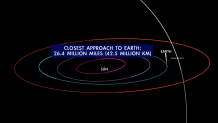Last time Comet C/2022 E3 (ZTF) was in the neighborhood was 48,000 B.C., and the world has a pair of telescopes at Palomar Mountain to thank for discovering it buzzing nearby this time around.
Starting next week, some lucky stargazers may be able to put eyes on what most folks are calling the Green Comet, though it's much more likely that they'll need at least a pair of binoculars, or, better still, a telescope.
The comet is passing through the inner solar system, reaching perihelion, with its closest approach to the sun on Jan. 12. Since then, it's been growing brighter and, on Feb. 2, will be its closest to the Earth. It's been hanging around in the Oort Cloud for an eternity. Literally.

Get top local stories in San Diego delivered to you every morning. Sign up for NBC San Diego's News Headlines newsletter.
“Comets are notoriously unpredictable, but if this one continues its current trend in brightness, it'll be easy to spot with binoculars, and it's just possible it could become visible to the unaided eye under dark skies,” according to NASA’s Jet Propulsion Laboratory at the California Institute of Technology.
Its discoverers — who laid "eyes" on Comet C/2022 E3 for the first time last March when it was inside Jupiter's orbit — employed the Zwicky Transient Facility (ZTF), which is named for Caltech astronomer Fritz Zwicky. ZTF is the latest in an "arc of optical transient projects hosted on the Palomar Oschin and 60-inch telescopes," according to the Palomar Observatory's website.
Wait, wait, there's more: "A novel 570 megapixel camera paired with the Oschin operates as the robotic discovery engine for ZTF, and the 60-inch telescope robotically provides followup low-dispersion optical spectroscopy for rapid transient source classification."
Local
How Palomar Found the Green Comet
"This was discovered by a robotic survey system that is run in Pasadena [by observatory owner and operator Caltech]," Steven Flanders, the observatory's outreach and event coordinator, told NBC 7 on Wednesday.
Flanders said the system photographs the entire night sky every other evening, then artificial intelligence software is used to analyze the archive of images to "subtract" objects in the sky that were already there.
The "artificial intelligence has been taught to look for things that are interesting," is how Flanders put it.
After discovering Comet C/2022 E3 (ZTF), a "circular" was sent to the Minor Planet Center, which tracks such things, and the first two people whose names are on the circular — Bryce Bolin and Frank Mascie (among many other names) — are considered to be the comet's discoverers, Flanders said.
They're not making a big deal out of this up on Palomar Mountain.
While in the past there have been "nighttime star parties" for the observatory's Friends organization, which were held outside the facility's compound ("no viewing on any research telescopes ever," Flanders said), no such event is planned in the coming weeks. Flander said that had to do with the fact that the observatory can't have any unvaccinated people anywhere on campus, which is Caltech's policy.
Where and When Can You See Comet C/2022 E3 (ZTF)?
“Comets are notoriously unpredictable, but if this one continues its current trend in brightness, it'll be easy to spot with binoculars, and it's just possible it could become visible to the unaided eye under dark skies,” according to NASA’s Jet Propulsion Laboratory at the California Institute of Technology.
Observers in the Northern Hemisphere will be able to see the comet in the morning sky, NASA says.
It was last in the solar system during the Upper Paleolithic era in the Ice Ages but whether it was visible from Earth then is not known. It could have passed outside the orbit of Jupiter, according to NASA.
“Since then the new long-period comet has brightened substantially and is now sweeping across the northern constellation Corona Borealis in predawn skies,” NASA stated.
This is not the first time down the comet-discovery path for the Palomar Observatory.
"The famous fragmented comet that collided with Jupiter in 1994, Comet Shoemaker-Levy 9, and a number of transneptunian objects, including Eris, that triggered the revision of planet definition and the demotion of Pluto as a planet were also discovered with Palomar telescopes," according to the observatory.



